The History of Martin 45-Series Acoustic Guitars
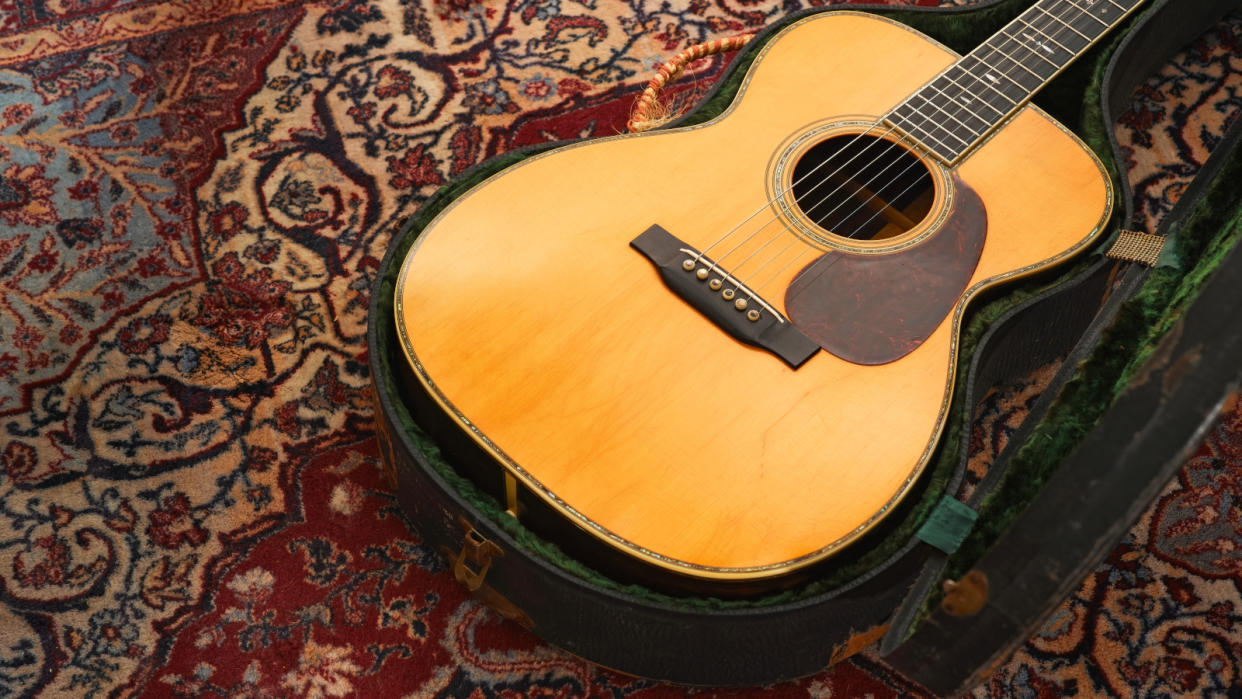
Few flat-tops command the reverence of a Martin 45. Emerging in the early part of the 20th century and few in number, they are now some of the most collectible acoustic guitars known. Among them are the D-45s. These Dreadnoughts are to Martin what the ’Burst is to Gibson: a Holy Grail guitar worth hundreds of thousands of dollars valued not only in terms of scarcity and looks, but also on its merits as a playing instrument.
When ’Burst/rare guitar collector Andrew Raymond happened to show us this 1937 Martin 000-45 on a recent shoot, we thought we’d take the opportunity to perform some close-up camerawork and bring our readers a little nearer to what Martin still considers to be the apex of flat-tops.
“A beautiful guitar both in tone and in appearance,” reads the 000-45 entry in Martin’s 1937 catalogue. While the website today, declares: “It’s the perfect guitar for any discerning collector or musician. Nothing says you’ve arrived like a D-45.”
It seems the decades have done little to dampen the luster of these artful instruments or quell the lust of collectors and players.
“We have a pre-war D-45 that’s part of our museum collection,” begins Martin’s museum and archives specialist, Jason Ahner. “And on the plaque is written, ‘The Holy Grail of acoustic guitars.’ I mean, it’s an iconic guitar, and if you see one at auction you want to buy, you’d better have a few hundred thousand dollars to spend!”
Evolving from Style 42 instruments, Martin’s first Style 45 flat-tops were registered in 1904 in the form of two 0-45s and one 00-45, followed by one 000-45 in 1906. It wasn’t until 1933 that the first D-45 was built (at the behest of Gene Autry) after Martin began making Dreadnoughts branded under its own name in 1931.
“The 45-series has its origins in the 42-series,” says Jason. “The 00-42S is really where the Style 45 developed from. In those days, ‘S’ meant it was a ‘special order’ instrument. A few of them were built in 1901, but the majority were made in 1902. From there, Martin went on to release Style 45 instruments in 1904.”
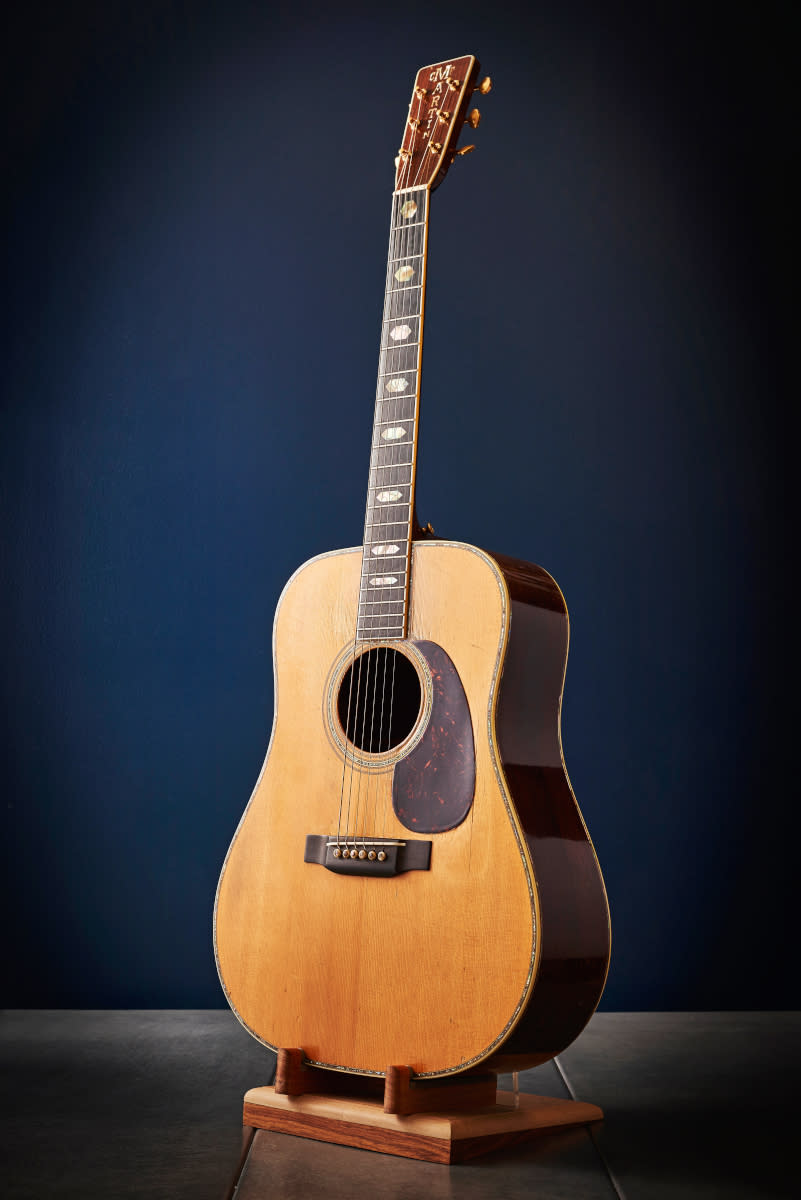
In many ways, the Martin D/Dreadnought design became the standard by which all other American flat-tops are judged. Indeed, 0, 00 and 000 size acoustics are these days referred to as ‘small-bodied’. And yet, at one point or another, each of the above claimed the title of Martin’s largest flat-top.
“Martin’s first X-braced guitar was made for Madame de Goñi in 1843, and it’s a size 1 – the largest size Martin was building at the time,” says Jason. “And then you see the larger size 0 first built in 1854, followed by the first 00 in 1858. But sales records don’t mention the first 000 until 1902. From there, the 000 is the largest body size until the Dreadnought is built exclusively for Ditson [in 1916]. Ditson went out of business in 1930, and the following year Martin started building the Dreadnought model for all their dealers, although it didn’t become a 14-fret neck model until 1934.”
The evolution of Martin guitars from a 12- to a 14-fret neck via the OM/Orchestra Model instruments introduced in 1929 is considered a leap forward in flat-top design. Interestingly, the design stems from a special-order guitar requested by a banjo player.
Not only do they look great, but they sound great
“The Orchestra Models are directly related to a banjo player named Perry Bechtel,” points out Jason. “He had been playing archtop guitars with longer necks, but he wanted a flat-top guitar with a longer neck, too, and at that time nobody built one. He happened to work for a Martin dealer in Atlanta, Georgia, called the Cable Piano Company, and so he started negotiating what he wanted. Eventually, Martin would build a guitar for him: the first OM-28. It’s considered the first modern steel-string acoustic guitar with the longer, slimmer 14-fret neck.”
The new OM-style 14-fret neck became so successful that, by 1934, Martin had switched a majority of its existing line over from the older 12-fret design, including the 45-series.
“Martin was building the OM from 1929 until 1934, and that’s when they started building the 000 with a 14-fret neck also. At that point, the OM and the 000 were pretty much the same guitars, so they just discontinued the OM. There were no longer OM-18s, OM-28, or OM-45s: they just became 000-18, -28, and -45s [respectively]. For a few months, 000s were actually the same scale as the OMs. So, in 1934, you could find, say, a 000-28 and an OM-28 that were pretty much exactly the same guitar, except for the [model name] stamping on the neck. But then, later in the year, Martin decided to shorten the 000 scale from 25.4 inches to 24.9 inches.”
While Hawaiian music reigned supreme in the 1920s, the guitar was still a little bit behind the mandolin and banjo in terms of popularity, and it is precisely for these reasons that the flat-top continued to evolve in the way it did.
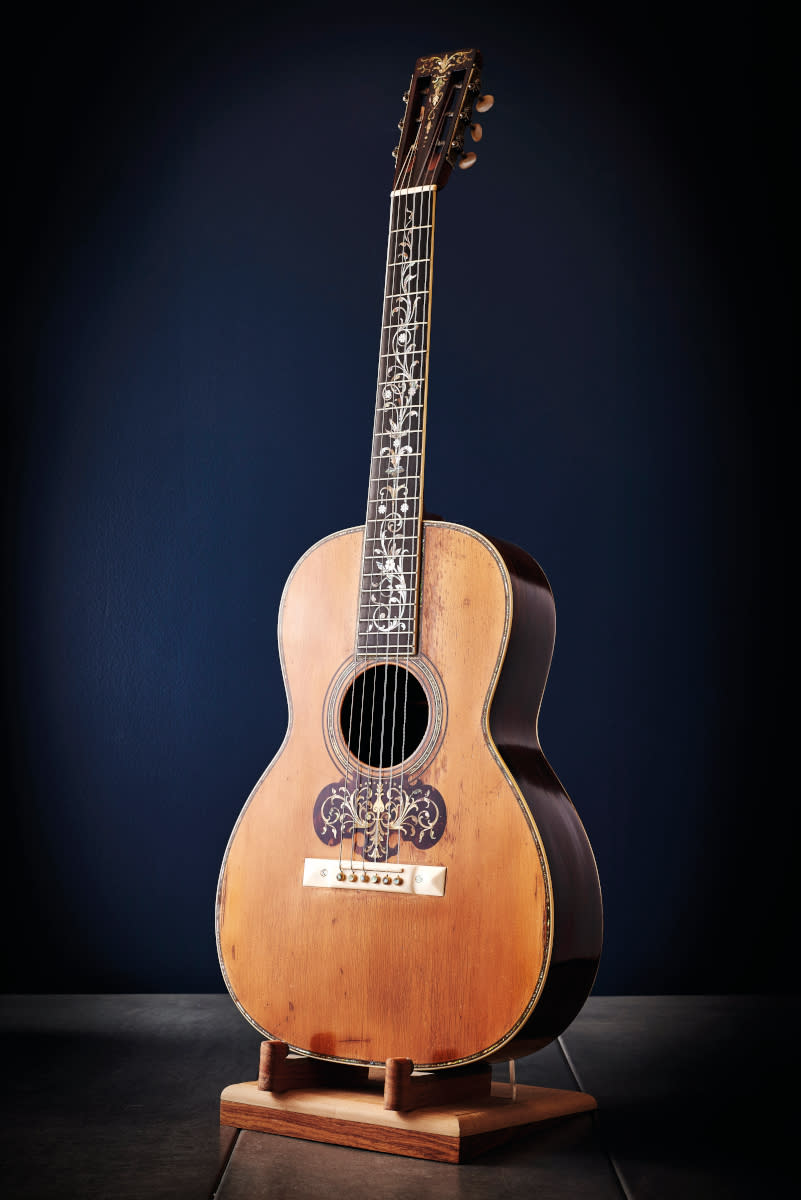
“Guitars were often just an instrument that would keep the rhythm in the background,” explains Jason. “It wasn’t really until the 1930s that it came more to the forefront as a lead instrument and to accompany vocals. If you look at the 00-42S [pictured here] it has that mandolin-style pickguard on it. Later on, Martin would switch to what we now consider to be a more traditional pickguard when it was ordered, but they didn’t become standard until the OM/Orchestra Models appeared in 1929. Those were the first models to feature a pickguard as standard. Also, around that time during 1927/1928, steel strings become the standard and gut strings are on a special order basis instead, which shows how music was developing.
“The more I look into it and the more I learn, the more I see how Hawaiian music influenced the way the guitar is played now. Hawaiian musicians were the first to put steel strings on a guitar. It was the gentlemen by the name of Joseph Kekuku [1874-1932] and Mekia Kealaka‘i [1867-1944]. They were childhood friends. Martin built the pre-Dreadnought guitar for [Kealaka‘i], and a couple of months later built the D-111 Dreadnought for Ditson [in 1916]. Then, in 1931, Martin’s D-1 and D-2 came out.
“Because of the popularity of Hawaiian music, Hawaiian musicians were touring all over the States, and you can hear elements of their style in blues music and country – the pedal steel, for example. A lot of the early blues guitarists played slide. Take Robert Johnson: he would use a slide, and that could easily have come directly from Hawaiian music. I think the guitar wouldn’t be played the same nowadays had it not been for Hawaiian musicians.”
It’s the flagship model, so you’re going to get the best of the best
Although the pictured 1937 000-45 now resides in Wales, it spent many a year in the decidedly more tropical climes of Hawaii.
“It wouldn’t have been that unusual for a 000-45 such as this to have been in Hawaii because there was always a big connection between Martin guitars and Hawaiian music,” underlines Jason. “I mean the Royal Hawaiian Band would purchase Martin ukuleles and guitars, and The Bishop Museum in Honolulu recently did an exhibition called ‘[Kaula Piko:] The Source Of Strings’. We lent them a pre-war 00-40H, which was a Hawaiian model Martin built. So there’s a big connection there and it goes back a long way.
“In the pre-war era, 45-style guitars were catalogued and remarked as Martin’s flagship instruments. Martin was building some archtops at the time in the F-series, and they were pretty pricey models, too, but if you look at, say, an OM-45 De Luxe, that would have been Martin’s most expensive model in 1930 [priced at $225]. And then from there, typically the 000-45 or the D-45 would have been the most expensive flat-top model in the price list.
“In 1937, Martin built 18 000-45s [priced $175]. Sales were pretty modest. The U.S. was still going through the Great Depression and $175 dollars was a costly sum back then. The production totals I have in front of me go up to 2005, and from the first 000-45 in 1906 up until then, Martin has only built 341 of them. So they’re pretty rare if you consider we build about 3,000 D-28s a year now – compared with 341 in the span of 100 years! We don’t build a 000-45 now – we build a 000-42 and an OM-42 – but the D-45 is currently available in our Standard Series.”

As is the case with Martin’s current top-of-the-line 42- and 45-series flat-tops, this 1937 000-45 was built using specially selected wood.
“It has premium Adirondack spruce for the top, along with premium Brazilian rosewood for the back and sides,” highlights Jason. “It’s the flagship model, so you’re going to get the best of the best when it comes to the look of the wood. The ebony used for the fingerboard and bridge would have come from Africa – most likely it’s Gabon ebony. Gabon usually has more of a uniform black color, which is pretty much what you see exclusively until the 1990s.
“It has ivoroid binding and the nut and saddle are ivory. All of the pearl is abalone, which is much more colorful than just white mother-of-pearl. The fretboard inlays are what we call the long-pattern snowflake type. The Style 45 long-pattern snowflake fretboard inlays include the 1st and 3rd frets through to the 17th, as opposed to the Style 42 snowflakes that start at the 5th fret. Also, Style 45s have pearl inlay on the headplate, which 42s didn’t. 45s changed over from the Martin torch inlay to the CF Martin block logo inlay – as seen on this guitar – in the 1930s.


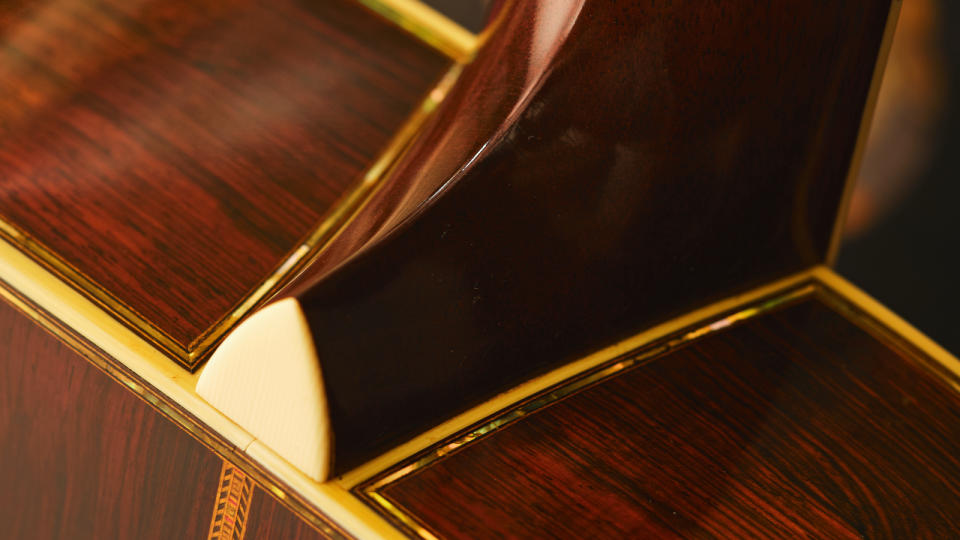
“The finish is a nitrocellulose lacquer, which is connected to ukulele production. Martin was having such a hard time keeping up with production that in 1926 they brought in their first spraying equipment to do nitrocellulose lacquer.”
While a majority of Martin’s classic guitar design features were in place by the 1930s, further developments were necessary in order to reinforce the necks.
“In 1937, guitars such as this 000-45 were being made with a steel T-bar installed in the neck,” Jason tells us. “I think Martin ordered them from a sled manufacturer! Originally, when they got into steel-strings, they were just using a strip of ebony to reinforce the neck, although at that point they were still using bar frets, so that acted as compression fretting to help keep the neck straight. But in 1934, Martin went to modern-style T-frets, and because they didn’t have the same compression rate as bar frets, something stiffer was needed to reinforce the neck – which is when they brought the T-bar in. That was replaced by a square steel tube in the 1960s, before the adjustable truss-rod became standard in 1985.”
Due to the war effort and materials shortages, production of 45-style guitars ceased in 1942, shortly followed by 42-style guitars early the following year.
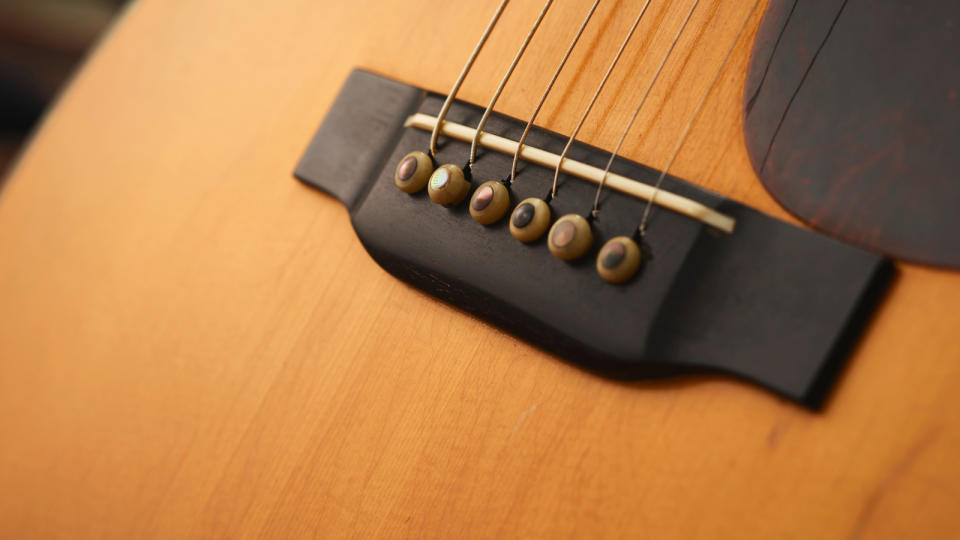
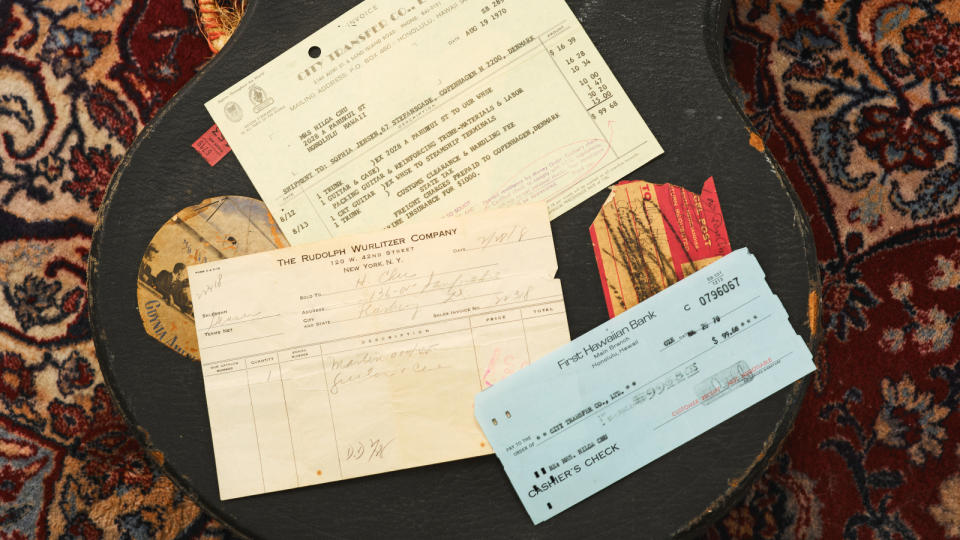

“1943 was the last year for all pearl-’boarded guitars (six 000-42s built in February 1943),” says Jason. “Then there were no pearl-’boarded models until 1968 when Martin reintroduced the D-45, followed by the 000-45 in 1970. So, until the D-35 was introduced [in 1966], the highest appointment level Martin offered was a 28 style.
“In the 60s, Martin saw the market growing for pre-war D-45s and they wanted to reintroduce it, so they brought [Martin author] Mike Longworth in to oversee the production because he was an excellent inlay artist and because of his reputation. He did work for Lester Flatt and Eric Clapton, including Clapton’s 1966 000-28, which he converted to a Style 45 – the one he plays on the MTV Unplugged show, along with his 1939 000-42.
“When it comes to acoustic guitars, Style 45s are the pinnacle of what a flat-top steel-string can be. And that’s what makes them so valuable. Not just because they’re Martins. Martin has built great guitars since 1833, but 45s have really stood up to the test of time. Not only do they look great, but they sound great.
“If you pick up a Style 45 from the 1930s like this, you’re going to get an amazing sound; you’re going to get what you expect to hear from a Martin instrument.”
With thanks to Andrew Raymond of Vintage ‘n’ Rare Guitars in Bath, U.K.

